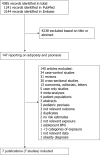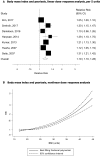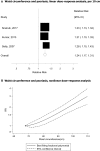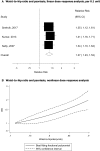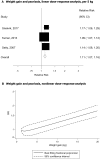Body mass index, abdominal fatness, weight gain and the risk of psoriasis: a systematic review and dose-response meta-analysis of prospective studies
- PMID: 29680995
- PMCID: PMC6290660
- DOI: 10.1007/s10654-018-0366-z
Body mass index, abdominal fatness, weight gain and the risk of psoriasis: a systematic review and dose-response meta-analysis of prospective studies
Abstract
Greater body mass index (BMI) has been associated with increased risk of psoriasis in case-control and cross-sectional studies, however, the evidence from prospective studies has been limited. We conducted a systematic review and dose-response meta-analysis of different adiposity measures and the risk of psoriasis to provide a more robust summary of the evidence based on data from prospective studies. PubMed and Embase databases were searched for relevant studies up to August 8th 2017. Summary relative risks (RRs) and 95% confidence intervals (CIs) were calculated using a random effects model. The summary relative risk (RR) for a 5 unit increment in BMI was 1.19 (95% CI 1.10-1.28, I2 = 83%, n = 7). The association appeared to be stronger at higher compared to lower levels of BMI, pnonlinearity < 0.0001, and the lowest risk was observed at a BMI around 20. The summary RR was 1.24 (95% CI 1.17-1.31, I2 = 0%, pheterogeneity = 0.72, n = 3) per 10 cm increase in waist circumference, 1.37 (95% CI 1.23-1.53, I2 = 0%, pheterogeneity = 0.93, n = 3) per 0.1 unit increase in waist-to-hip ratio, and 1.11 (95% CI 1.07-1.16, I2 = 47%, pheterogeneity = 0.15, n = 3) per 5 kg of weight gain. Adiposity as measured by BMI, waist circumference, waist-to-hip ratio, and weight gain is associated with increased risk of psoriasis.
Keywords: Body mass index; Meta-analysis; Psoriasis; Systematic review; Waist circumference; Waist-to-hip ratio; Weight gain.
Conflict of interest statement
The authors declare that there are no conflicts of interest.
Figures
Similar articles
-
Anthropometric factors and ovarian cancer risk: a systematic review and nonlinear dose-response meta-analysis of prospective studies.Int J Cancer. 2015 Apr 15;136(8):1888-98. doi: 10.1002/ijc.29207. Epub 2014 Sep 24. Int J Cancer. 2015. PMID: 25250505
-
The association between body mass index, abdominal fatness, and weight change and the risk of adult asthma: a systematic review and meta-analysis of cohort studies.Sci Rep. 2023 May 12;13(1):7745. doi: 10.1038/s41598-023-31373-6. Sci Rep. 2023. PMID: 37173338 Free PMC article.
-
Body mass index, abdominal fatness, and the risk of sudden cardiac death: a systematic review and dose-response meta-analysis of prospective studies.Eur J Epidemiol. 2018 Aug;33(8):711-722. doi: 10.1007/s10654-017-0353-9. Epub 2018 Feb 7. Eur J Epidemiol. 2018. PMID: 29417316 Free PMC article.
-
Body mass index, abdominal fatness, weight gain and the risk of urinary incontinence: a systematic review and dose-response meta-analysis of prospective studies.BJOG. 2019 Nov;126(12):1424-1433. doi: 10.1111/1471-0528.15897. BJOG. 2019. PMID: 31376211
-
High Body Mass Index and Central Adiposity Is Associated with Increased Risk of Acute Pancreatitis: A Meta-Analysis.Dig Dis Sci. 2021 Apr;66(4):1249-1267. doi: 10.1007/s10620-020-06275-6. Epub 2020 Jun 19. Dig Dis Sci. 2021. PMID: 32556971 Free PMC article.
Cited by
-
An Observational Study of 147 Psoriasis Patients: Overweightness and Obesity as a Significant Clinical Factors Correlated with Psoriasis.Medicina (Kaunas). 2023 Nov 15;59(11):2006. doi: 10.3390/medicina59112006. Medicina (Kaunas). 2023. PMID: 38004054 Free PMC article.
-
The Link Between Weight-Adjusted-Waist Index and Psoriasis in Adults: A Cross-Sectional Study Based on 2009-2014 and 2003-2006 Data.Clin Cosmet Investig Dermatol. 2024 Aug 5;17:1763-1772. doi: 10.2147/CCID.S471528. eCollection 2024. Clin Cosmet Investig Dermatol. 2024. PMID: 39132027 Free PMC article.
-
Diabetes Detection and Prevention in Dermatology.Dermatol Pract Concept. 2021 Sep 1;11(4):e2021131. doi: 10.5826/dpc.1104a131. eCollection 2021 Sep. Dermatol Pract Concept. 2021. PMID: 34631273 Free PMC article. Review.
-
Methylenetetrahydrofolate Reductase C677T Gene Polymorphism as Risk Factor for Psoriasis in Saudis.Biomark Insights. 2019 Feb 24;14:1177271919830973. doi: 10.1177/1177271919830973. eCollection 2019. Biomark Insights. 2019. PMID: 30828245 Free PMC article.
-
An Update on the Role of Adipose Tissues in Psoriasis.Front Immunol. 2019 Jun 28;10:1507. doi: 10.3389/fimmu.2019.01507. eCollection 2019. Front Immunol. 2019. PMID: 31316526 Free PMC article. Review.
References
Publication types
MeSH terms
LinkOut - more resources
Full Text Sources
Other Literature Sources
Medical

